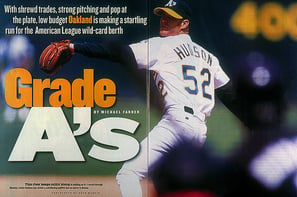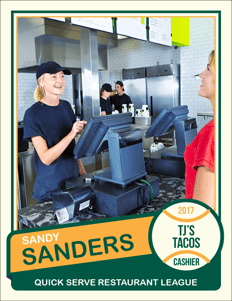The Moneyball Approach to Restaurant Operations
 Laura Johnson
Laura Johnson

How Restaurants Are Using Data Science to Climb Up the Standings
Whether or not you are a fan of baseball, you have likely heard the term “Moneyball” referenced at one time or another.

The term originates from a 2003 book of the same name (turned hit movie with Brad Pitt) about Billy Beane, General Manager of the
Oakland Athletics, who would go on to become a sports analytics pioneer. Beane challenged the conventional wisdom of Major League Baseball by building a winning baseball team through a groundbreaking, data-driven approach.
Prior to Beane’s revelation, GMs attempting to solidify their roster resorted to a manual, “go out and see them play” methodology. This antiquated, albeit pervasive method relied almost exclusively on the keen eye of upper-level scouts (think Clint Eastwood in Trouble with the Curve) and the all-important “stat-line” (Batting Average, Home Runs, Stolen Bases, RBI, etc.). However, Billy Beane’s new approach, dubbed “sabermetrics*,” relied less on the old school, manual scouting element and more on data science (specifically advanced quantitative statistical analysis) to determine a players’ worth as well as their fit to his existing ball club.
As the story goes, Beane was able to use his data-driven approach to make under the radar player signings and lead the cash-strapped, talent-depleted 2002 Oakland A’s to a 20-game win streak and the second best record in baseball. This monumental season forever solidified the legitimacy of data science in baseball, and sports abound, and everyone lived happily ever after.
While Moneyball (the book/film) is a story about sports, the fact of the matter is that Moneyball (the idea) extends well beyond the “ball.” Yes, you may need to be a baseball fan to recall the likes of Miguel Tejada or Scott Hatteberg, or to fully appreciate the impact that Billy Beane has had on the evolution of the game; but you DON’T need to be a fan to recognize that the concept has applications outside of sports.  Businesses are becoming eager to incorporate advanced data analytics into their decision-making. They are leaning on data science to present them with qualitative, data supported insight on how to improve efficiency, streamline operations, and boost profits. And, while more and more industries are embracing the Moneyball mentality, there may not be a better depiction of its potential than in the restaurant industry.
Businesses are becoming eager to incorporate advanced data analytics into their decision-making. They are leaning on data science to present them with qualitative, data supported insight on how to improve efficiency, streamline operations, and boost profits. And, while more and more industries are embracing the Moneyball mentality, there may not be a better depiction of its potential than in the restaurant industry.
*Sabermetrics was actually invented in the 70’s; however, Beane revolutionized its use in baseball.
Think Beyond the Traditional “Stat Line”
 Using data to gauge restaurant performance is not necessarily a new concept. Just as Billy Beane did not invent using data to analyze player performance, restaurant operators have been using data for decades to make decisions. But were they looking at the right numbers? In baseball, the stats listed on the back of the baseball card (Batting Average, Home Runs, Stolen Bases, On Base Percentage, etc.) were traditionally the measure of a player’s value. In the same vein, basic restaurant metrics such as voids, discounts, promos, sales, and table turns have long been used as a baseline to gauge employee and overall restaurant performance.
Using data to gauge restaurant performance is not necessarily a new concept. Just as Billy Beane did not invent using data to analyze player performance, restaurant operators have been using data for decades to make decisions. But were they looking at the right numbers? In baseball, the stats listed on the back of the baseball card (Batting Average, Home Runs, Stolen Bases, On Base Percentage, etc.) were traditionally the measure of a player’s value. In the same vein, basic restaurant metrics such as voids, discounts, promos, sales, and table turns have long been used as a baseline to gauge employee and overall restaurant performance.
The underlying flaw with using these basic KPIs are that they lack context when comparing restaurants or employees that are not the same. As Beane realized in baseball, although batting average counts their importance at a 1:1 ratio, a single and a homerun have varying levels of importance and should be valued differently. The same goes for the common metrics used to measure restaurant performance.
As an example of a “sabermetric way” of looking at restaurant data, take advanced KPIs like RI (Risk Index) and SPI (Sales Performance Index). These formulas combine basic stats like voids, discounts, promos (risk index) and sale, upsell, table turns (sales index) and combine, normalize, and add weights by overall importance or impact to even the playing field. The resulting score better represents the true performance of your server or restaurant in question.
Contemplate this: Employee A works at a high traffic restaurant in Manhattan, amassing 50 voids in a week for a total of $200 and Employee B at a low traffic restaurant in rural Nebraska compiling 30 voids in a week for a total of $125. Who is the riskier associate? At first glance, Employee A has more voids for more money, however taking the stat-line at face value does not take into consideration: restaurant foot traffic (frequency of targeted activity vs. all activity), the likelihood of theft (cash vs. credit tender), the breakdown of dollar values, etc. After digging into the less surface-level data points, you actually see that Employee B is the associate that should be flagged for review.
Creating a Restaurant Data Analytics Dynasty
The Moneyball thought process is also applicable to decisions outside of staff and restaurant performance. Restaurant optimization is just as important to sustaining success and relevancy as putting a competent & honest staff out there. Just as baseball teams need to use the resources they have at their disposal to get the best bang for their buck, complement their high-cost players with effective role players, and stay ahead of the changing league trends; restaurants need to do the same thing.
Some of the important areas of focus when optimizing restaurant operations include maximizing profits on sales opportunities, streamlining food and labor costs, and staying ahead of trends in the marketplace. Restaurants that do this put themselves in the best position to compete at a high-level year after year. By taking an advanced data analytics approach to understanding how your restaurant stacks up in these categories, you can give yourself a leg up over those restaurants only using their sales, margin, and other basic metrics today as an indicator of how they will perform tomorrow.
Performing advanced analysis on menu mix, item sales, and prep times can provide deep insight into areas where you can streamline operations, reduce food costs, and increase customer satisfaction. Performing qualitative analyses around staffing (by day part, revenue center, day of week, etc.) helps you reduce labor costs, and ensure maximum efficiency throughout your restaurant. Knowing when and where your items are and are not selling can help you optimize your menu and avoid wasted inventory. Additionally, measuring margin by menu item can call attention to items that may be costing you money, and where you can balance out those items by mixing up entrée and side pairings.
Challenge Conventional Wisdom & Break Old Habits
 As much as the Moneyball mentality is a story about the power of applying advanced data analysis to business decisions, it is also a lesson in questioning the status quo. Billy Beane showed scouts, GM’s, and front offices that player evaluation did not need to be a time-consuming process of watching hours of tape and manually reviewing box scores. This same mentality can be applied to evaluating the methods that your restaurant uses to monitor and benchmark performance.
As much as the Moneyball mentality is a story about the power of applying advanced data analysis to business decisions, it is also a lesson in questioning the status quo. Billy Beane showed scouts, GM’s, and front offices that player evaluation did not need to be a time-consuming process of watching hours of tape and manually reviewing box scores. This same mentality can be applied to evaluating the methods that your restaurant uses to monitor and benchmark performance.
Traditionally, restaurants utilize technology like video analytics and restaurant management systems to monitor and track their daily operations. Video can be a powerful tool to have at your restaurant’s disposal, but using video analytics software as the primary method of restaurant reporting mirrors the “old school” manual scouting methodology that Beane strayed away from. If you sit there long enough, you MIGHT find the next Babe Ruth an issue that needs to be addressed, but by watching video and manually reviewing checks to look for areas of interest, you are wasting valuable resources in the process.
Alternatively, restaurant management software is a valuable tool for restaurant managers to perform & track day-to-day tasks and restaurant happenings. However, what restaurant management software inherently lacks is the ability to view data from a qualitative, companywide standpoint, instead focusing on location-by-location data analysis, and streamlining basic tasks like scheduling and payroll that a restaurant manager performs each day.
To bring the Moneyball mindset to your restaurant, there is advanced data analytics software that makes it easier to summarize data at a company-wide scale so you can make comparisons, see trends, and act on data that would otherwise not be visible. These tools make it easier than ever to prioritize the metrics that are important to your business and automate alerts and workflows so that the software identifies these opportunities for you. Much like Billy Beane did judging player data from a qualitative standpoint to make connections far beyond what would be possible by solely looking game-by-game, this same philosophy can open doors for restaurants to gain insight into preventable loss and operational enhancement opportunities that embody the message that “Moneyball” puts forward.
Subscribe to our blog
Receive free educational resources like exclusive reports, webinars, and industry thought leadership articles straight to your inbox.


